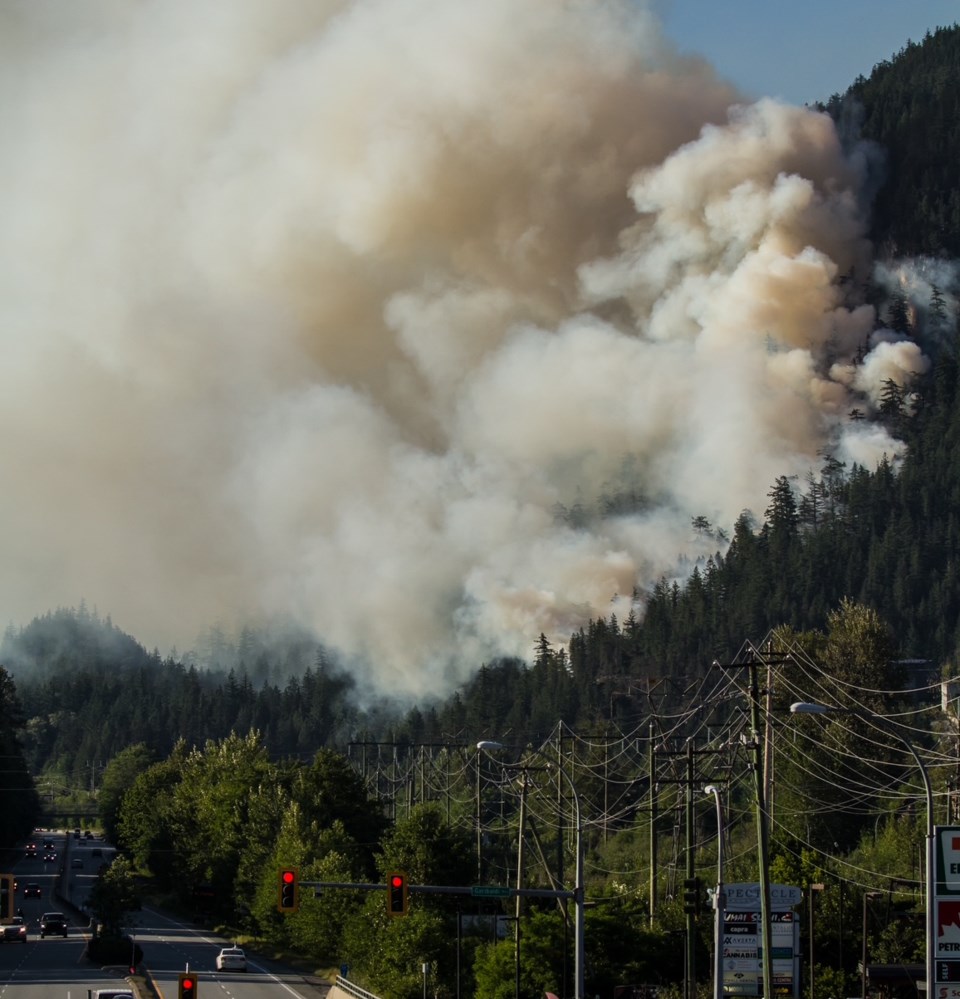In all the times I’ve written about wildfires in this column, it’s mostly been about how lucky Whistler has been. A mountain town nestled amongst coniferous rainforest—baked dry during spring and early summer heat waves—is incredibly susceptible to the swift and destructive nature of an out-of-control wildfire (just ask the residents of Jasper, Alta.). During my years here I’ve seen Blackcomb Mountain ablaze in 2009 (a fire ignited by a lightning strike that almost burned down the old Crystal Chair) and several summers when smoke has blanketed the town from fires in surrounding valleys. But other than the odd flare-up from careless human behaviour (the story about the guy burning his toilet paper in the woods and the wind picking it up is a prime example of not-funny), there hasn’t been a fire in Whistler where I’ve genuinely feared for our homes and lives. It always seems to happen somewhere else.
That changed for me last week. Not in Whistler, but at my new home on the northern end of Squamish. As I write this, the Dryden Creek wildfire is classified as “being held,” which is an immense relief after six days of watching the DeBeck’s Hill smoke plume up from my bedroom window.
It began as a video in a group chat in the early evening on Monday, June 9, showing an Avro RJ85 Airtanker dropping its bright red fire retardant payload. The caption from my straight-to-the-point friend reading: “DeBeck’s Hill fire.” A couple hours later, I was sitting on my patio doing my best to relax during a warm summer evening. In the span of about 90 seconds, I spotted three fixed-wing aircraft flying to and from the fire with the thwap of a couple helicopters soon thereafter.
The social media wave soon hit with Squamish locals posting images of a wall of flame making its way down the hill toward their homes. Few folks slept well that night, even those of us who weren’t in immediate danger. The evacuation alert was in place for dozens of homes in the Brackendale and Tantalus Road areas, but no one was ordered to leave yet. Have your bags packed and be ready, was the word.
As all this was shaking out, I was doing my best to manage my own preparation. I was texting with neighbours who were visiting family in Ontario, asking them to send me a list of what I should grab from their house if our part of town had to evacuate in a hurry. I made my own list and plan, tracking down higher-value items that still hadn’t found their permanent place in my new home after the recent move. I placed them all in a corner of my room next to a duffle bag of clothes, rain gear and warm layers. I made sure I had enough dog food for a couple of weeks and checked my truck had at least three-quarters of a tank of gas.
Concentrating on my work responsibilities for the first half of the week proved challenging. I was in my home office, checking for online wildfire updates every few hours (shoutout to the team at The Squamish Chief for their diligent reporting) and more often looking out my bedroom window for first-hand evidence of how the fire was progressing. The southern flank near the Brackendale homes was holding, with a few of the residential lots on the frontline now rigged up with sprinklers constantly spraying the roofs, trees and ground brush (kudos to the community members who pitched in for this hard work alongside the BC Wildfire personnel). I had done all I could at this point. Now came the anxious wait.
While me and my home were not directly threatened during the Dryden Creek wildfire, I understood the anxiety of people who were affected. You crave information—how big is it now? Is it growing? When can I expect the next update?—but the people communicating that information can only tell you what they know. The size of fire can become difficult to estimate when smoke or hazy skies are obscuring aircraft observation. The state of the wildfire is given a binary designation of being held or out of control. But out of control doesn’t necessarily mean the fire is expanding on all fronts and raging toward you, your family and your community. It just means the fire is not shrinking. Waiting it out a few kilometres away from an out-of-control wildfire certainly didn’t make me more comfortable last week, but it did make me realize the situation is very much, well, out of my control. I did my best to take the advice from the evacuees of the Sandy Lake First Nation wildfire in northern Ontario: “Don’t panic. Eat bannock!”
With the spring and summer seasons as hot and dry as they are now, I know this won’t be the first time I’ll be on edge about a wildfire encroaching on my community. But if and when it does happen, I know I’ll be prepared, and a little more calm.
Vince Shuley is ready for more rain. For questions, comments or suggestions for The Outsider, email [email protected] or Instagram @whis_vince.




